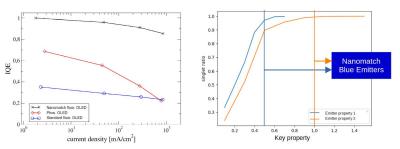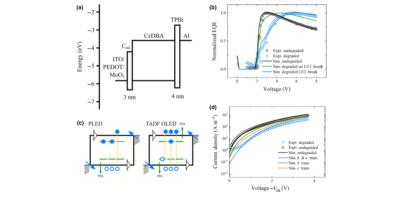TADF OLED emitters, introduction and market status - Page 3
Researchers design the world's highest-efficiency narrow-emission deep-blue TADF OLED emitter
Researchers from Korea's KAIST institute, in collaboration with Gyeongsang National University developed a new TADF OLED deep-blue emitter molecule that achieves an EQE of 33%. Combined with a fluorescent emitter to create a hyperfluorescence system, the researchers achieved an EQE of 35.4%, with mitigated efficiency roll-off. The researchers say that this is the world's highest-efficiency narrow-band deep-blue TADF OLED emitter.
To develop the new emitter the researchers introduced sterically hindered peripheral phenyl groups to boron-based TADF emitter. The resulting material, o-Tol-ν-DABNA-Me, offers a pure narrowband emission that is far less sensitive to concentration compared to standard TADF emitters.
Researchers reach 100% IQE with a single-layer TADF device, getting closer to commercial viability
A few months ago we reported on research conducted at Germany's Max Planck Institute, led by Prof. Paul W.M. Blom, that looks into single-layer OLED devices. In such devices, a single TADF OLED emitter layer is sandwiched between two electrode - a much simpler design compared to commercial OLED devices that use multilayer stacks, sometimes with 10 or more layers.
The researchers the the MPI say that in fact it is possible to develop highly efficient OLEDs with just the TADF emitter, as there's no fundamental reason or major benefits that arise from multilayer OLEDs. The researchers continue their work, and now they have developed a new single-layer blue OLED in which every injected electron is converted into a photon - or 100% IQE. This is the first time that such a single-layer OLED device was demonstrated (see image above).
Researchers develop an efficient stretchable TADF OLED emitter
Researchers at the University of Chicago, led by Sihong Wang (above) and Juan de Pablo, developed a stretchable OLED device that uses TADF emitters to enable high efficiency and high stretchability.
The researchers say that this is the highest-efficiency stretchable display demonstrated to date, as all previous designs used fluorescent OLED emitters. The TADF stretchable device achieves 10% EQE and a stretchability of 125%. The substrate of this new device is a newly synthesized polymer.
Wisechip announces its second TADF/HF PMOLED device
PMOLED display maker Wisechip has launched its second TADF/HF OLED display, a 5.5" 256x64 yellow PMOLED device. The company says that by using Kyulux's Hyperfluoresence™ OLED technology it offers double the brightness compared to its standard OLEDs.
Wisechip is the first and only company to commercialize TADF/HF device. The company's first device was launched in 2020, a 2.7" yellow PMOLED.
Nanomatch announces a novel class of emitters for efficient and stable blue OLEDs
This is a sponsored post by Nanomatch
Using their in-house virtual design tools, Nanomatch developed a new class of emitters that enables the production of stable, fluorescent OLED devices with close to 100% internal quantum efficiency also in the blue color range.
The specific class of fluorescent emitters facilitates the generation of only singlets with radiative decay of the order of 10-8s, thereby eliminating quenching processes induced by long-lived triplets. Having filed the patent end of February 2023, Nanomatch is now looking for partners to commercialize this new concept in order to realize efficient, stable blue OLEDs on an industrial level.
Is current OLED architecture obsolete? An interview with the head of Germany's Max Planck Institute
Researchers from Germany's Max Planck Institute, led by Prof. Paul W.M. Blom, are looking into single-layer OLED devices (in which a single emitting layer is sandwiched between two electrodes), with an aim to match their efficiencies to those of common multilayer OLED stacks, like the ones used in commercial OLED displays.
Current OLED architectures utilize multilayer stacks of materials, in order to increase the performance and lifetime of OLED devices. But according to the latest findings by Prof. Blom, equal efficiencies can indeed be met with single-layer TADF OLED emitters - and there's no fundamental reason or major benefits that arise from multilayer OLEDs.
Researchers suggest using the dipole moments of TADF host materials to increase emission performance
Researchers from the University of Cambridge, led by Dr Alex Gillett, have studied the effect of host materials (the dielectric environment) on the performance of TADF OLED emitters, and specifically how the dipole moment of the host material can affect the rISC rate of the TADF component.
The impact of the toluene solvent dynamics on the riSC process of TXO-TPA (left: TXO-TPA in an explicit toluene solvent environment, right: TXO-TPA in vacuum)
The researchers tested several TADF OLED materials, and in some of these materials, the effect of different host materials can be quite dramatic. It is believed that commercial TADF devices could benefit from tuning the host and emitter combination to achieve higher performance, including a better efficiency roll-off as conversion of triplets into singlets can be accelerated.
Researchers from Shenzhen University designed efficient selenium-integrated TADF OLED emitters
Researchers from China's Shenzhen University are working towards efficient selenium-integrated TADF OLED emitters.
The researchers latest work detailed the structure-activity relationship between heavy atom effects and multiple resonance TADF performance. The researchers say that their new emitters effectively solve some of the issues inherent in TADF emission technology, specifically the sharp drop in emission at high brightness, what is called the emission roll-off.
Researchers develop new highly-efficient cyanopyrazine-enhanced fluorophores OLED emitters
Researchers from Russia's Ural Federal University developed a new OLED emitters based on cyanopyrazine-enhanced fluorophores. The presence of cyanogroup substance in the composition of fluorophores significantly increases the efficiency of the OLED emitters.

The researchers say that they have modified the pyrazine-based push-pull system with cyanogroup and studied how this affected the photophysical properties of the fluorophores and the performance of OLED devices based on these materials.
Samsung Display acquires TADF material developer Cynora
According to reports, Samsung Display acquired OLED material developer Cynora, for about $300 million. Samsung acquires just the IP and technology, and Cynora terminated its entire workforce a couple of weeks ago. Samsung is already an investor in Cynora, and so is LGD.

Cynora has been low on cash (its last financing round was in 2019), according to reports, and did not manage to find new investors, and so the company opted to be sold to Samsung. The reported sum seems to be rather high for an emergency exit, and some later reports quotes much lower sums, perhaps even around $30 million or so.
Pagination
- Previous page
- Page 3
- Next page








